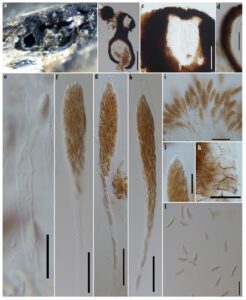Allocryptovalsa microspora M. Niranjan & V.V. Sarma sp. nov. Figs. 1 a–l
Etymology – The new species has smaller ascospores when compared to all other existing species of Allocryptovalsa.
Index fungiorum number: IF 558364;
Description
Saprobic on an unidentified twig. Teleomorph: Stromata immersed in the host tissues; Ascomata 280–300 × 110–130 µm, perithecial, immersed, single or grouped, globose, with a long neck, central wide halo-region, closed inner depressed layer. Peridium thick, consists of two layers, outer thick textura globosa and inner textura angularis cells. Hamathecium paraphyses aseptate, unbranched, longer than asci. Asci 40–125 × 12.5–17.5µm (= 74.5 × 13.4, n=25), unitunicate, multispored, clavate, numerous, with an ocular chamber and an apical pore, funnel-shaped, J–ve, in Lugol’s solution, long-pedicellate. Ascospores 5.5–10 × 2.5–2.75 µm (= 7.9 × 2.75, n=25), gold color, allantoid, smooth-walled, obtuse ends. Anamorph: Undetermined.
Material examined – India, Andaman and Nicobar Islands, South Andaman, Kalatan. (11˚47’59.1”N 92˚42’46.8”E). Recorded on un-identified twig, 4 January, 2017, M. Niranjan & V.V.Sarma (PUFNI 17465). Additional specimens examined – Middle Andaman, Rangat, Nilambur, (12°10’15.6″N 92°47’09.1″E), on unidentified twig (T115F1, T117F1), 07 January, 2017.
Notes − Senwanna et al. (2017) introduced the genus Allocryptovalsa in Diatrypaceae family, based on stromata immersed in host tissues, polysporous asci and allantoid ascospores and molecular sequence data, sharing similarities with Cryptovalsa. Presently Allocryptovalsa consists of 6 species that have distinct dimensions and are provided in Table 1. The new taxon Allocryptovalsa microspora is closely related to A. rabenhorstii (Mehrabi et al. 2016; Senwanna et al. 2017). However, the ascospores are slightly smaller and narrower (5.5–10 × 2.5–2.75 μm vs. (12−) 13−15 (−16) × (2.5−) 3−4 (−5)) in the former when compared to the latter. Further, A. rabenhorstii has ascospores that densely accumulate at apical ends of asci in contrast to A. microscpora. Also A. microspora has close relation with Cryptovalsa ampellina (Mostert et al. 2004, Mehrabi et al. 2015) in having a linear arrangement of individual ascomata, but differs in having smaller asci and broader ascospores (5.5–10 × 2.5–2.75 vs. 7– (8– 9) –11 × 2 μm). Further, species in Cryptovalsa have the perithecial outer surface coated with white, powdery entostroma, which are lacking in our new species (Zhu et al., 2020). A. microspora also has similarities to C. mangrovei (Inderbitzin et al. 1999) but, the asci are short and wider (40-125 × 12.5–17.5 vs. 77–207 × 5–15 μm); and A. castanea but with larger asci than A. castanea (40–125 × 12.5–17.5 vs. 60–83(−92) × (11–) 12.5–17.5) (Zhu et al. 2020). A. microspora has narrower asci and smaller ascospores as compared to the existing species. In addition, A. microspora has linear ascomata rather than in groups. Based on the above morphological similarities, A. microspora is introduced here in Allocryptovalsa as a new species.
Figs.1 Allocryptovalsa microspora (PUFNI 17465) a Ascomata in vertical section b Ostiolate neck with periphysis d Peridium e Paraphyses f–i Asci j Apical pore, k Textura angularis l Allantoid ascospores. Scale bars: b= 100 µm c,d,i = 50 µm f–h= 20 µm e, j–l = 10 µm.

